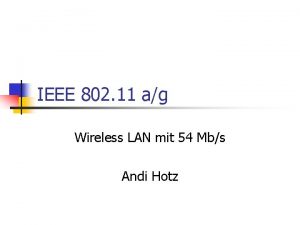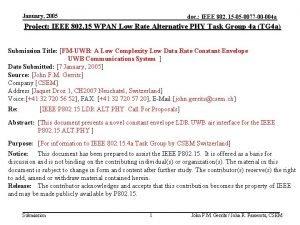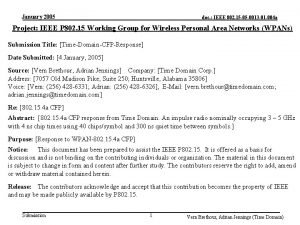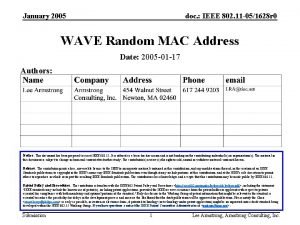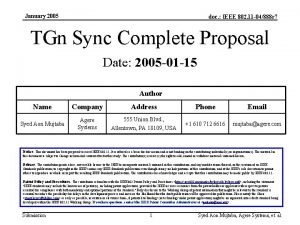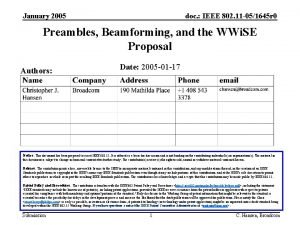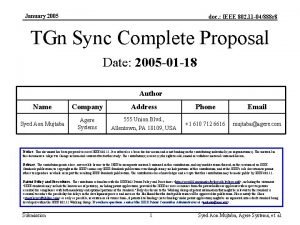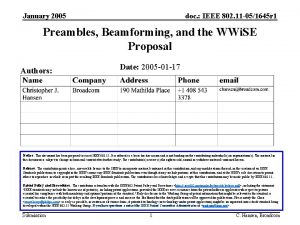January 2005 doc IEEE 802 11 050070 r











- Slides: 11

January 2005 doc. : IEEE 802. 11 -05/0070 r 0 Useful Considerations for Tightly Controlled Networks Joe Epstein Meru Networks Submission 1 Joe Epstein

January 2005 doc. : IEEE 802. 11 -05/0070 r 0 Contents • • • Background Uses Considerations Approaches Found To Be Useful What Might Help Now Summary Submission 2 Joe Epstein

January 2005 doc. : IEEE 802. 11 -05/0070 r 0 Background • What do I mean by tight control? – Where the network tries to manage station behaviors and parameters quickly enough to adapt to changing channel conditions • Usually to provide capacity/performance improvements or better predictability • Degree of tightness varies from purpose to purpose. – This is quicker than configuration, such as AP frequency selection • 802. 11 k and –v lend themselves to such a network – 802. 11 k provides methods for intelligent network (centralized or distributed) to get good, relevant information – 802. 11 v could provide methods for the network to control behavior Submission 3 Joe Epstein

January 2005 doc. : IEEE 802. 11 -05/0070 r 0 Uses Found tight control valuable for • Voice over WLAN – Resource and capacity considerations dominate • High-density data networks – Even when average case doesn’t have high densities, impromptu meetings or lobbies can cause areas of high density that benefit from tight control • Mixed-use (voice + data) networks • 2. 4 GHz band networks – Inter-cellular capacity bound Submission 4 Joe Epstein

January 2005 doc. : IEEE 802. 11 -05/0070 r 0 Considerations Within one cell • High densities challenge backoff-based cells – EDCF exacerbates the problem with shorter backoffs – Best to use polling…if client supports it! • Overall, cells become very delicate at high load • Rate adaptation can break cell – Any errors—including common channel noise—can cause one station to drop rate, which reduces available slots for contention and increases contenders – Cascading rate drops follow – Not a configuration issue • Can’t just remove low rates—they’re needed for range Submission 5 Joe Epstein

January 2005 doc. : IEEE 802. 11 -05/0070 r 0 Considerations (2) Inter-cell • Cells overlap in 2. 4 GHz – Three-coloring for minimum coverage always can cause hidden stations * • This is the hidden overlap * – What’s above is theoretical minimum overlap! – Networks are usually deployed with more overlap, to allow more than one AP to be heard at every spot Submission 6 Joe Epstein

January 2005 doc. : IEEE 802. 11 -05/0070 r 0 Considerations (3) • 2. 4 GHz continued… – Three-coloring with higher rate guaranteed coverage guarantees plenty of overlap • Channel-changing on handoffs can be bad for some applications (Voice) – 802. 11 r may minimize handoff times, but there are other factors to consider (such as scanning-battery tradeoffs) – There still may be deployments where same-channel overlap is by design, even with 802. 11 a Submission 7 Joe Epstein

January 2005 doc. : IEEE 802. 11 -05/0070 r 0 Approaches Found To Be Useful • Assignment – What we’ve found most useful is being able to assign APs to clients, in real time – Lends itself to load balancing – When directed by the network, the optimizations can take into account more information than is locally available within the cell or nearest neighbor • Global vs. Local – More information leads to better analysis – Even if some heuristics work well with local neighborhoods, it would be good to support arbitrary neighborhood sizes Submission 8 Joe Epstein

January 2005 doc. : IEEE 802. 11 -05/0070 r 0 Approaches Found To Be Useful (2) • Proper resource/load calculations – QAPs must take these into consideration – Often needs to account for larger-order neighborhood effects • Inter-cell scheduling across cells on same channel – TDM across cells to get channels to “feather in” Submission 9 Joe Epstein

January 2005 doc. : IEEE 802. 11 -05/0070 r 0 What Might Help Now Not anywhere near a complete list! Also, many of these mechanisms could be very delicate • Network-directed handoff – Request for client to move to a different BSSID – Should allow including specific BSSID(s) and their channels • Setting Cell-based parameters (rather than AP-based) – Such as • Station RTS-CTS threshold • Station Transmit Power Levels – Must delicately balance issues of management authority and ensuring uniform channel access – Special attention to transitions across areas of differing cell parameters • Setting/suggesting queue sizes, per class – For both clients and AP – Suggest head dropping… • • Limiting transmit rates (possibly different for each queue) Limiting retry counts (possibly different for each queue) Submission 10 Joe Epstein

January 2005 doc. : IEEE 802. 11 -05/0070 r 0 Summary • 802. 11 v provides opportunity to create tight control mechanisms for performance assurance and optimizations • Performance and stability problems are real, but are solvable • Specific mechanisms, and types of mechanisms, can be added from AP to Client to gain these benefits Submission 11 Joe Epstein











